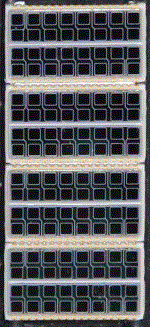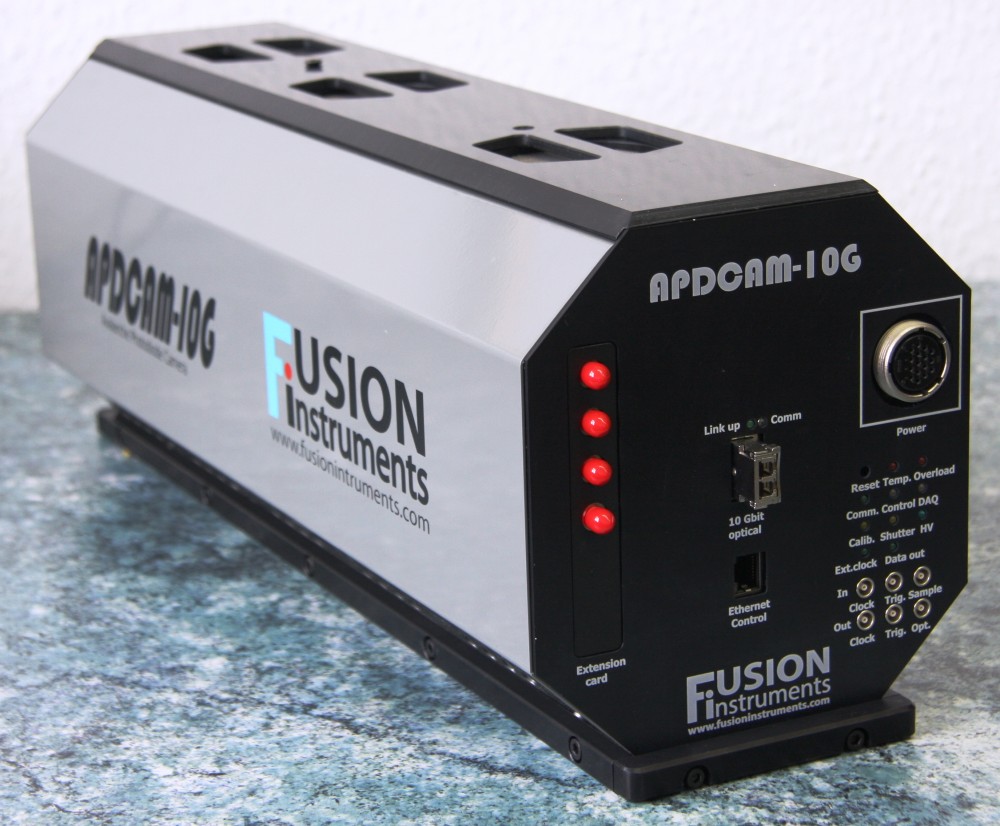Overview

APDCAM-10G is a modular Avalanche Photodiode (APD) detector camera capable of using up to four Hamamatsu S-8550 4×8 pixel APD arrays. This way various pixel configurations are available: 4×16, 4×32, 8×8, 8×16. Additionally the FC64 version uses 64 individual detectors with SMA fibre coupling. The photo below shows the 8×16 pixel configuration with 128 pixels.

Each APD pixel in APDCAM-10G has its own low noise amplifier and Analog to Digital Converter (ADC). The amplifier parameters are matched to the expected photon flux and target measurement frequency of the application in order to provide the optimal Signal to Noise Ratio. The data stream resulting from the ADCs is directly transmitted to the computer via a 10 Gbit Ethernet connection which allows the exceptionally fast 4 MHz sampling rate for 128 channels. The same interface is used for controlling the camera operation.
APDCAM-10G contains the usual complete infrastructure found in the APDCAM family: temperature controlled detectors, calibration lights, various clock and trigger schemes. Additionally the device can be equipped with up to 4 optical fibres arranged around the detectors for spectral measurements and/or calibration.
Like other devices in the APDCAM family this device can also be ordered with micro-lens array and magnetic field hardened electronics.
Features
- 64-128 APD pixels in 4×16, 4×32, 8×8 or 8×16 matrix, individual low noise amplifiers and ADCs for each pixel.
- Hamamatsu S8550 detector, 1.6×1.6 mm pixel size, 2.3 mm pixel pitch.
- Alternative is Hamamatsu S13361-2050 MPPC matrix.
- Also available with 64 individual detectors (any mixture of APD/MPPC).
- Custom detector arrangements and types possible.
- Quantum efficiency max. 85% (in red).
- Detector gain: 2-50 adjustable by detector bias voltage.
- Micro-lens array for detector (optional).
- Detector temperature control ±15 degrees from ambient.
- Analog bandwidth DC to 0.1-1 MHz (order parameter).
- Typical noise equivalent photon flux 2-5 10^7 photon/s.
(depending on analog amplifier settings). - 14 bit ADC, direct data transfer to PC memory.
- Individual pixel enable, resampling, digital filter in camera.
- 4 Ms/s sustained transfer rate with 128 pixels active. Higher rates with reduced number of pixels.
- Variety of triggering options: software, external trigger, internal level (adjustable per pixel), post trigger.
- External or internal clock reference.
- Adjustable level calibration light.
- Optical fibres around detector (optional).
- Built-in TTL-Fibre or Fibre-TTL trigger and clock converter (optional).
- Magnetic field hardened version (optional).
- 10 Gigabit Ethernet connection to PC (XFP fibre module).
- C language Software Development Kit (Linux).
- Python and IDL interface package.
- Size: 50*16*18.5 cm.
- Weight: 8 kg.
The figure below shows the block diagram of APDCAM-10G. For more details please see the APDCAM-10G User’s Guide or contact our team.
Manual
APDCAM-10G User’s guide: PDF
Software
Please ask for the packages below:
APDTest program binary (Linux 64 bit)
APDTest program source
Python interface package
Photos


